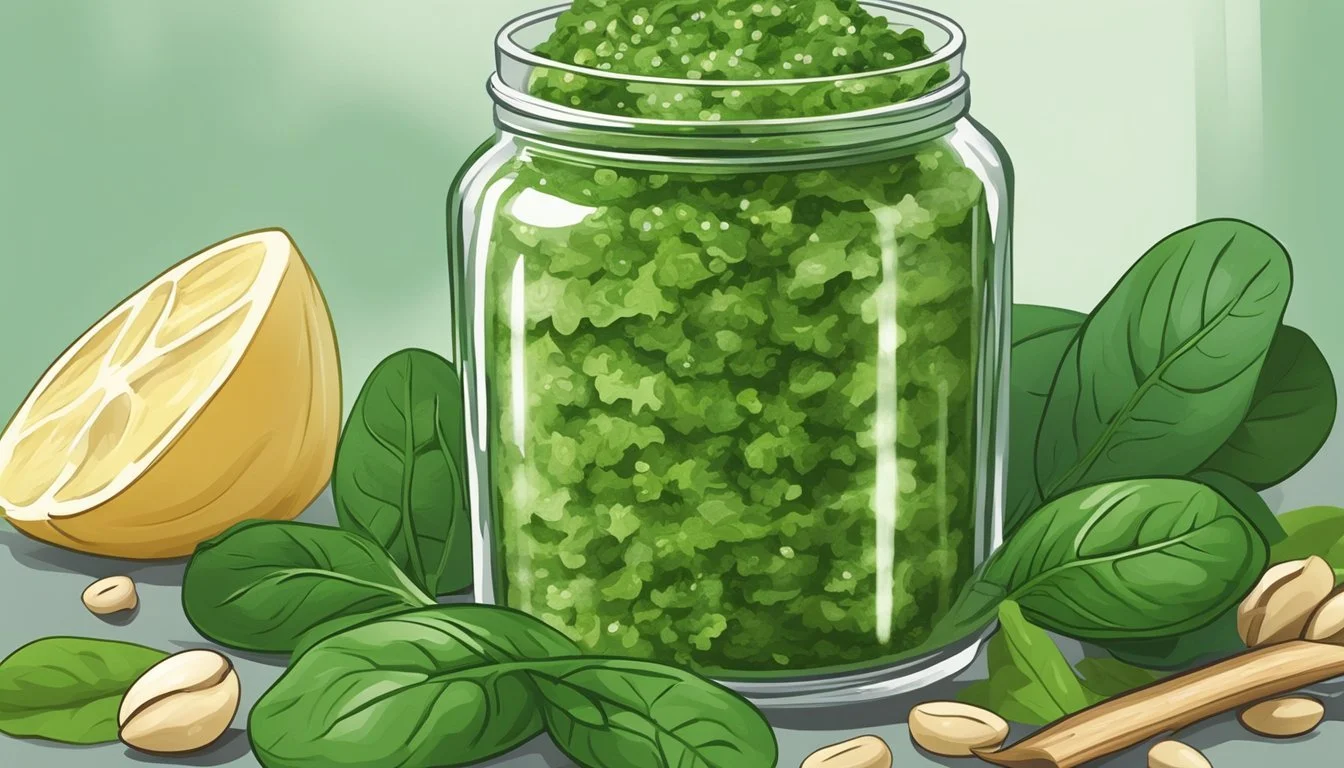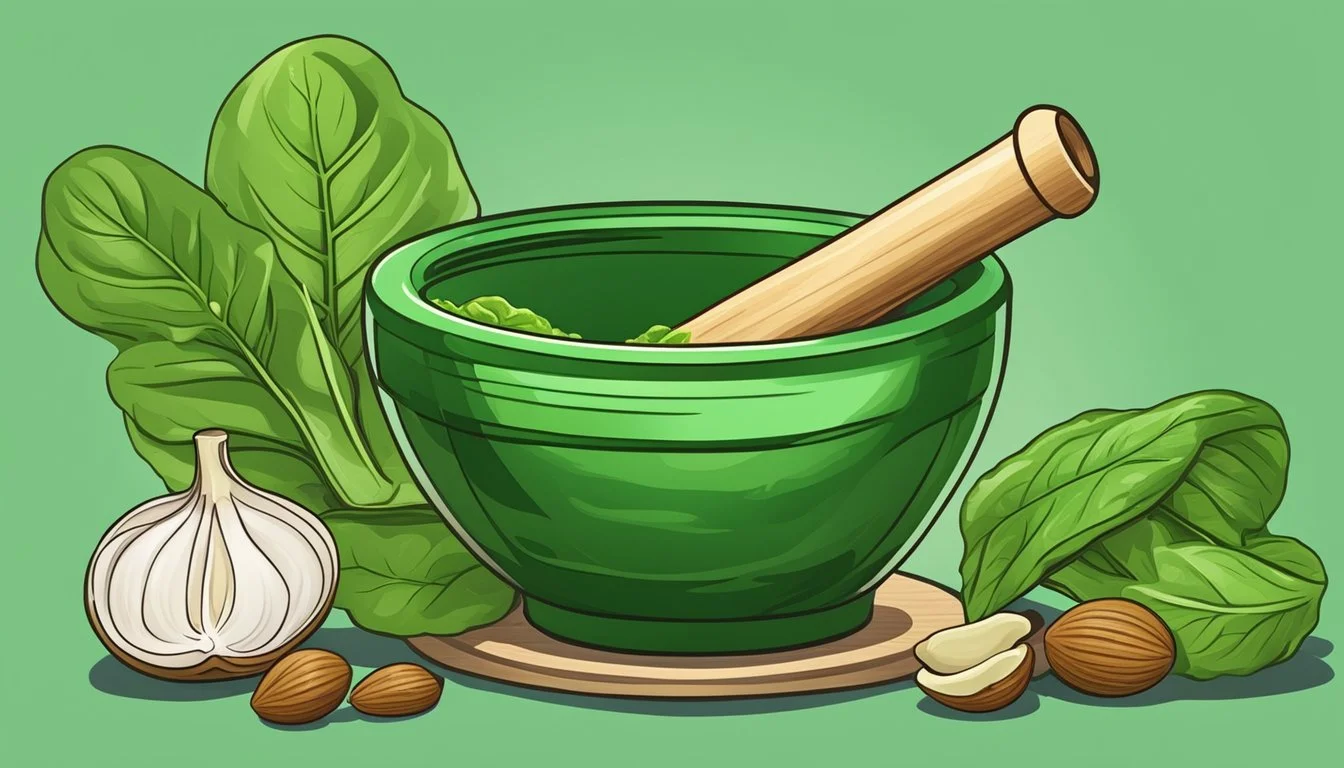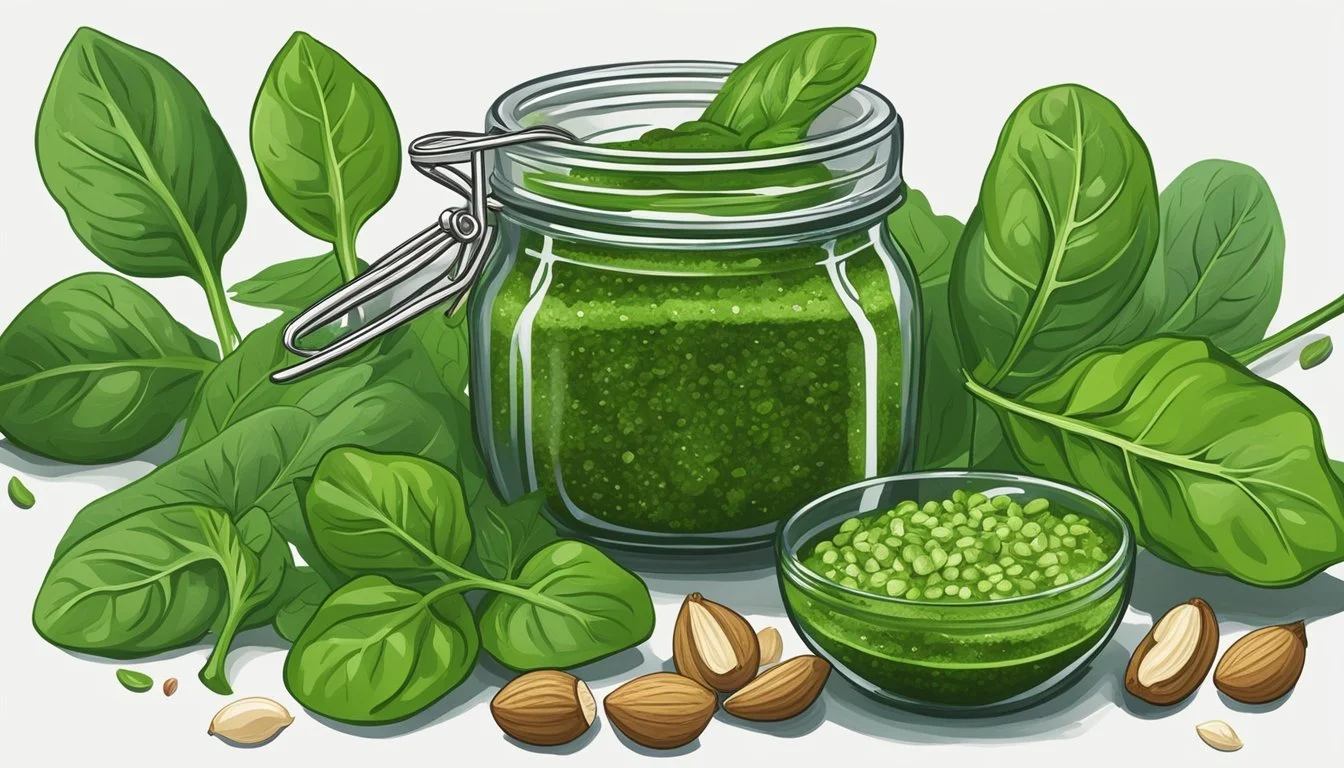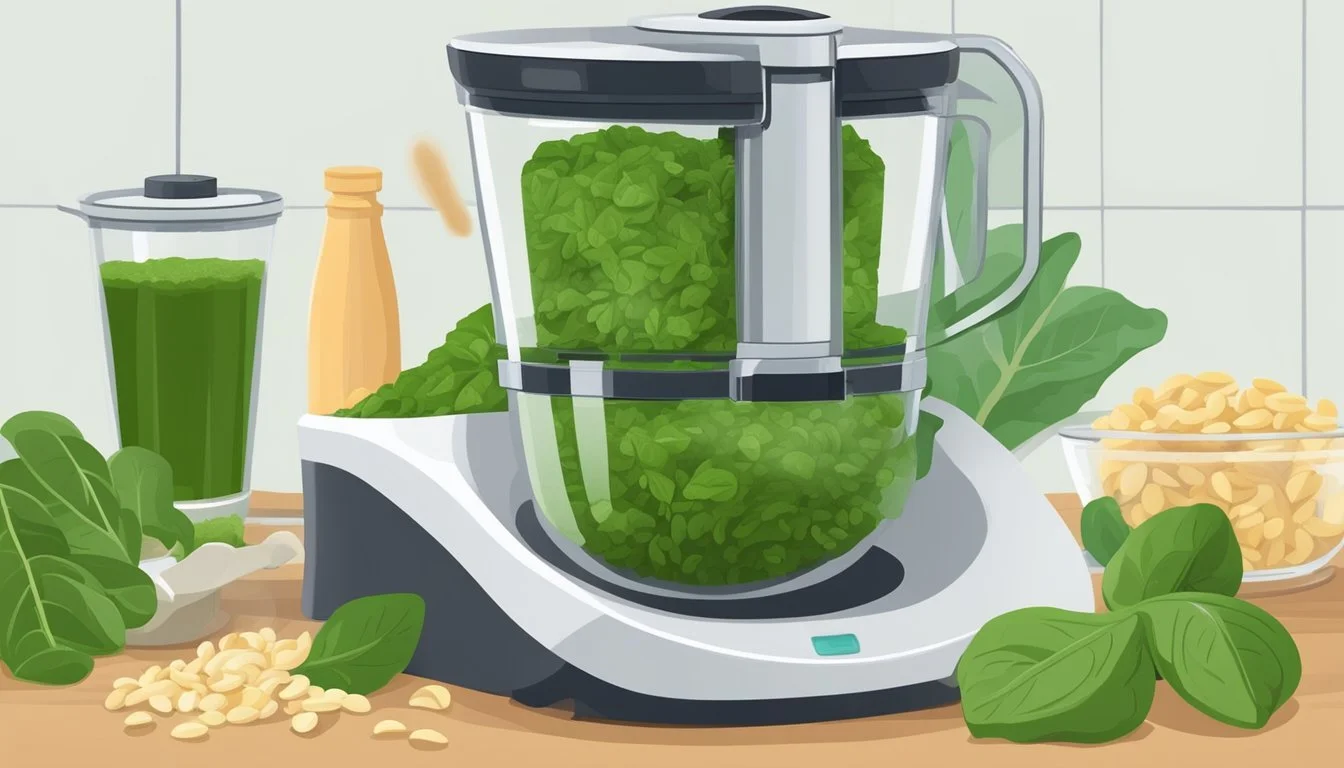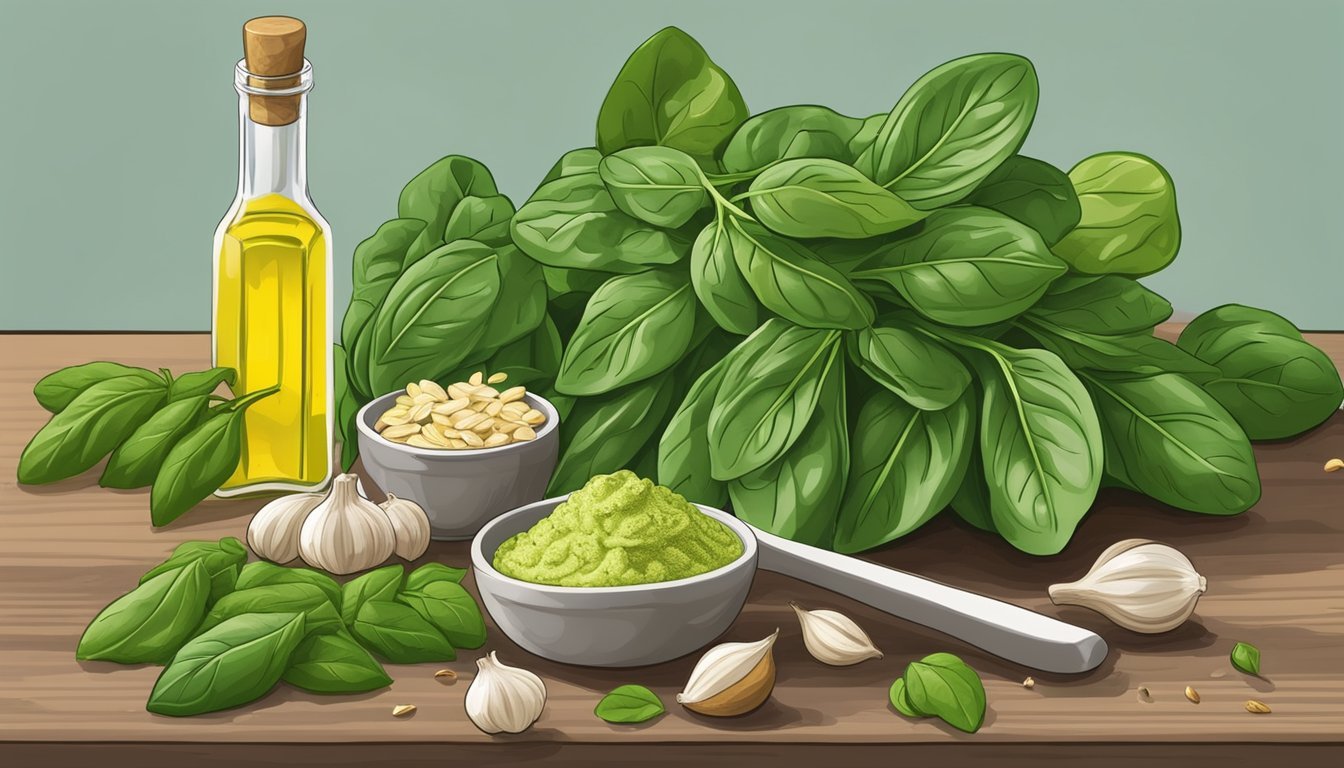Spinach Stem Pesto
An Iron-Rich, Flavorful Spread to Elevate Your Meals
Spinach (What wine goes well with spinach?) stem pesto offers a creative and nutritious twist on the traditional basil pesto. By incorporating the often-discarded stems of spinach leaves, this pesto variant not only reduces food waste but also intensifies the nutritional profile of the spread. Rich in iron and boasting a robust flavor, spinach stem pesto serves as a hearty complement to a variety of dishes, from pastas to bruschetta.
The process of making this flavorful spread is straightforward, utilizing the spinach stems that are typically trimmed and discarded. These stems contain valuable nutrients and fiber, contributing to the overall healthfulness of the pesto. Iron, an essential mineral found abundantly in both the leaves and stems of spinach, is pivotal for transporting oxygen in the blood and for numerous metabolic pathways.
In addition to its health benefits, spinach stem pesto brings a unique and full-bodied taste to culinary creations. It can be effortlessly tailored to personal preferences by adjusting the garlic content, the type of nuts or seeds used, and the balance of cheese and seasonings. The result is a spread that is not just healthy but also a versatile and environmentally friendly choice, curtailing waste one delicious spoonful at a time.
The Basics of Spinach Stem Pesto
Spinach stem pesto is a vibrant green sauce that is not only easy to prepare but also packs a hefty nutritional punch. This section will explore its composition and the unique advantages of incorporating spinach stems.
What is Spinach Pesto?
Spinach pesto is a variant of the classic pesto, traditionally made with basil. The spinach version replaces or complements basil with spinach leaves, and particularly for this type, includes the often-discarded stems. The basic ingredients of spinach pesto are:
Spinach: Both leaves and stems, thoroughly washed
Nuts: Pine nuts or alternatives like walnuts
Cheese: Typically Parmesan or a similar hard cheese
Garlic: Fresh cloves for a sharp depth of flavor
Olive Oil: Extra virgin for its fruity profile
Seasonings: Salt and pepper to taste
The process involves blending these components until a smooth or slightly chunky consistency is achieved, according to personal preference.
Benefits of Using Spinach Stems
The stems of spinach are rich in iron and fiber, making them a valuable addition to pesto. Including stems not only reduces waste but also enhances the nutritional profile of the pesto. The key benefits are:
Increased Fiber: Spinach stems contribute to the overall dietary fiber content, promoting digestive health.
Rich in Iron: Essential for blood formation, the iron content in spinach stems helps in preventing anemia.
Additional Nutrients: Spinach stems contain various nutrients that contribute to a healthy diet.
Spinach stem pesto is not only a healthy choice but also a smart culinary use of the entire spinach plant, offering a fuller utilization of its nutrients and flavors in cooking.
Selecting Your Ingredients
Crafting a delightful spinach stem pesto begins with the careful selection of fresh, high-quality ingredients. Each component contributes its unique flavor and texture to create a harmonious blend.
Choosing the Right Spinach
Fresh Spinach: When making pesto, fresh spinach is preferable for its vibrant color and robust flavor. One should select pre-washed and dried baby spinach to expedite preparation. Frozen Spinach can be used as an alternative but must be thoroughly defrosted and drained to remove excess moisture, which could dilute the pesto's flavor.
Nuts or Nut-Free Alternatives
Wealthy in texture and nutrients, nuts add a depth to pesto. Choices include:
Pine Nuts: Traditional and buttery, yet more expensive.
Walnuts: A wallet-friendly choice that introduces a slightly more robust flavor.
Almonds or Cashews: They offer a milder taste and creamier consistency.
Nut-free alternatives can be seeds such as sunflower or pumpkin seeds, but it will alter the final taste profile.
Selecting Quality Olive Oil
The olive oil acts as the pesto's base, so a high-quality extra-virgin olive oil is essential for a rich and smooth consistency. Its fruity notes should complement the greens and not overpower them. Start with a moderate amount, adjusting to reach the desired consistency.
Garlic and Its Substitutes
Garlic brings a pungent, earthy undertone. Fresh garlic cloves are ideal for their potent flavor, usually one or two, depending on size and personal taste preference. For a milder taste or when garlic is unavailable, garlic powder can be a substitute, but remember it’s more concentrated so use it sparingly.
Preparing Your Spinach
The success of a spinach pesto hinges on the quality and preparation of the spinach itself. Whether using fresh or frozen spinach, proper cleaning, and preparation will ensure that the pesto has the ideal texture and is free from impurities.
Cleaning and Preparing Fresh Spinach
Fresh spinach must be thoroughly washed to remove dirt and grit. One can place the spinach in a bowl of cold water, gently swish it around, and then lift it out into a colander to leave the heavier grit behind. A salad spinner can be highly effective for drying spinach leaves after washing. Spinach stems are nutrient-rich and can be included in making pesto for added texture and iron content. However, for more tender pesto, the leaves can be separated from the stems if preferred.
If one wishes to enhance the pesto's smoothness, blanching the spinach is an option. This quick cooking method involves placing the spinach leaves in boiling water for just a few seconds, followed by an immediate cool-down in ice water. Blanching the spinach will also help to retain a vibrant green color.
Working with Frozen Spinach
For frozen spinach, one needs to ensure that it is completely thawed before use. The easiest method is to leave the spinach in the refrigerator overnight or to defrost it in a microwave using a suitable setting. Once thawed, it is critical to remove excess water to avoid a watery pesto. One can achieve this by squeezing the spinach with clean hands or pressing it between two plates to extract the moisture. Frozen spinach is often pre-cooked, which makes it softer and may result in a smoother pesto, but it is essential to remember that it might have a more muted flavor compared to fresh spinach.
Creating the Perfect Pesto
Crafting the perfect pesto involves a delicate balance of flavors and the mastery of blending techniques. A harmonious blend of spinach stems and complementary ingredients results in a rich, iron-packed spread that's both versatile and delicious.
Blending Techniques
For the ideal texture, one should start by placing spinach stems and any additional leafy greens into a food processor or blender. Using medium speed, one should blend for approximately 10-15 seconds to achieve a chunky base. Key is to ensure that the greens are chopped but not pureed, preserving some texture for the final product.
To incorporate the garlic, cheese (typically Parmesan), salt, and pepper, pulsing a few times is recommended. These ingredients should be added after the initial blending of the greens to create layers within the pesto. This method helps distribute the flavors evenly, while also aiding in breaking down harder ingredients like the Parmesan to a more manageable consistency.
Balancing Flavors
The secret to a flavorful pesto lies in the balance of its core ingredients. The olive oil acts as the binding agent, enveloping the other components to form a creamy sauce. Start by adding a suggested amount and increase it in small increments until the desired consistency is achieved.
Lemon juice is essential for its acidity, which cuts through the richness, and should be added slowly to taste.
Salt and pepper are the final seasonings that should be adjusted carefully to enhance the pesto without overwhelming it.
By paying attention to the quantity and quality of these ingredients, one can create a pesto that is not just iron-rich, but also has a deep, complex flavor profile that complements a variety of dishes.
Customizing Your Pesto
A chef understands that a classic pesto recipe is a blueprint, one that welcomes creative adjustments. By modifying herbs and dairy components, one can tailor spinach stem pesto to fit dietary preferences and taste profiles, enriching its iron content and diversifying its flavor.
Incorporating Different Herbs
Basil, the traditional herb in pesto, imparts a sweet and peppery essence. However, one can also incorporate kale, known for its robust texture and earthy tones, or opt for a milder option such as parsley. Here's a quick guide:
Basil: Sweet and classic flavor, rich in vitamin K
Kale: Sturdy texture, nutrient-dense with vitamins A, C, and K
Parsley: Fresh taste, offers a lighter feel to the pesto
Vegan and Dairy-Free Variations
Parmesan cheese adds a salty and savory depth to pesto. For a vegan or dairy-free variation, nutritional yeast is an excellent substitute, bringing a similar umami profile while keeping the recipe plant-based. Nutritional choices like walnut can also be used for their rich, earthy flavor and additional nutritional benefits. To replace Parmesan:
Nutritional Yeast: For a cheesy flavor without dairy, sprinkle in to taste
Walnut: Use as a heart-healthy nut option for extra texture and nutrients
Nutritional Profile of Spinach Pesto
Spinach pesto merges the rich nutritional benefits of spinach with a variety of other healthful ingredients, creating a spread that is both flavorful and nutrient-dense. Notable for its high iron content and abundance of vitamins, it serves as a substantial source of nourishment.
Vitamins and Minerals
Spinach, the main component of spinach pesto, is an excellent source of iron which is vital in the prevention of anemia and plays a key role in the production of hemoglobin. The pesto is also high in fiber, supporting digestive health. Here is a brief rundown of its vitamin and mineral content:
Vitamin A: Crucial for vision, immune function, and skin health.
Vitamin K: Essential for blood clotting and bone health.
Vitamin C: Important for immune defense and collagen synthesis.
Potassium: Helps regulate fluid balance, muscle contractions, and nerve signals.
Antioxidants and Health Benefits
The assorted ingredients in spinach pesto bestow it with an array of antioxidants that are known to combat inflammation and may lower the risk of chronic diseases such as heart disease and cancer. The concentration of antioxidants in spinach makes the pesto particularly beneficial:
Flavonoids and carotenoids are two antioxidant groups found in spinach that have been studied for their health-promoting properties.
Regular consumption of foods rich in these antioxidants can contribute to the reduction of oxidative stress in the body.
In conclusion, spinach pesto is a confident choice for those seeking a knowledgeable blend of taste and nutrition. Its neutral taste profile makes it a versatile addition to various dishes, while its clear health benefits ensure it is more than just a flavorful indulgence.
Serving Suggestions
Spinach stem pesto, rich in iron and flavor, elevates a variety of dishes. Its robust composition makes it a versatile addition to both casual and sophisticated meals.
Main Courses
For a nutritious main course, spinach stem pesto pairs exceptionally well with pasta. It serves as a unique blend with traditional spaghetti or a creative binder for stuffed pastas like ravioli. When spread onto pizza, it can replace or accompany tomato-based sauces, adding a verdant twist to the beloved dish. Moreover, incorporating the pesto into rice dishes or as a topping for proteins such as chicken or beef can enhance their flavors and add a touch of freshness.
Appetizers and Dips
The robust flavor of spinach stem pesto makes it ideal for starters. As a dip, one can serve it with a platter of sliced vegetables or toasted pita, perfect for gatherings. Blending in a food processor until it acquires a smoother texture can transform it from a spread to a creamy base for a party dip. Consider adding extra olive oil or cream to adjust its consistency. As a starter, it pairs well with leafy green salads, where it could be used either as a dressing or a garnish.
Healthy Sandwich Spreads
Using spinach stem pesto as a sandwich spread introduces not only flavor but also a healthy twist to a classic lunch item. Spread it on whole-grain bread before layering with slices of turkey or roasted vegetables; the pesto acts as a moisture barrier, keeping the bread from getting soggy while amplifying the nutritional content. In wraps, spinach stem pesto can be spread thinly across the base before adding fillings, ensuring each bite contains an herbaceous kick.
Storing Homemade Pesto
Preserving the freshness and flavor of homemade pesto is crucial for maintaining its quality. It is important to follow specific storage methods to ensure the iron-rich spinach pesto retains its vibrant taste and nutrients.
Refrigerating Your Pesto
For short-term storage, refrigeration is key. Homemade spinach stem pesto should be stored in an airtight container to limit oxidation, which can lead to a loss of color and flavor. Place the pesto in the coldest part of the refrigerator, such as the back of a shelf where the temperature is most constant. It's recommended to consume the pesto within 7 days to ensure maximum freshness and taste.
Storage tip: To minimize air exposure, one can cover the surface of the pesto with a layer of olive oil before sealing the container.
Freezing for Long-Term Storage
To extend the life of homemade spinach stem pesto, freezing is an excellent option. Here's the optimal way to freeze your pesto:
Prepare freezer-safe containers or resealable freezer bags.
Fill with pesto, leaving a small space at the top as the pesto will expand when frozen.
Remove as much air as possible from freezer bags to protect against freezer burn.
Label with the date of storage, as homemade pesto can be stored in the freezer for up to 4 months.
When ready to use, thaw in the refrigerator or briefly run the sealed bag under warm water.
Using a food processor to blend the pesto ingredients ensures a smoother consistency that's ideal for freezing and later use.
Troubleshooting Common Issues
In making Spinach Stem Pesto, one may encounter challenges with texture and flavor. The key is to identify and rectify these issues to ensure a pleasantly creamy sauce with a balanced taste.
Fixing Texture and Consistency
Spinach Stem Pesto can sometimes turn out either too thick or too thin. The texture should be a creamy sauce that's easily spreadable.
If the pesto is too thick, gradually add olive oil, blending after each addition, until the sought consistency is achieved.
For a pesto that's too runny, one can incorporate more grated cheese or spinach stems in small amounts, blending it in until the mix thickens.
Adjusting Flavors After Blending
The flavor profile of Spinach Stem Pesto should not just be a bland, green spread, but a well-seasoned sauce with the right balance of taste.
If the pesto tastes too tart, adding a touch of grated cheese can balance out the acidity.
To counteract blandness, a pinch of sea salt may enhance the overall flavor profile.
A dash of freshly ground black pepper can add a warm, earthy note and elevate the spread.
Tasting and tweaking the flavors incrementally after blending will help achieve the ideal flavor balance.
Innovative Spinach Pesto Recipes
Spinach pesto is a versatile and iron-rich spread that can elevate the flavor profile of various dishes. By incorporating ingredients like artichokes (What wine goes well with artichokes?) and sun-dried tomatoes, these recipes put a creative twist on the classic pesto.
Spinach and Artichoke Pesto Dip
One transforms the traditional pesto into a creamy and indulgent appetizer perfect for gatherings. The combination of nutrient-rich spinach and tender artichokes offers a delightful texture contrast, which pairs well with a variety of dippers.
Ingredients:
2 cups fresh spinach leaves
1 cup canned artichoke hearts, drained and chopped
1/2 cup grated Parmesan cheese
1/4 cup pine nuts or walnuts
2 garlic cloves, minced
Olive oil, as needed
Salt and pepper, to taste
Instructions:
In a food processor, combine spinach, artichokes, Parmesan, nuts, and garlic.
Pulse until coarsely chopped, then gradually add olive oil until the desired consistency is reached.
Season with salt and pepper. Serve with crackers, sliced bread, or vegetable sticks.
Sun-Dried Tomato and Spinach Pesto
This recipe infuses the vibrant flavors of sun-dried tomatoes with the classic spinach pesto for a rich and tangy variant. It's an excellent spread for sandwiches, a flavorful sauce for pasta, or a savory topping for grilled meats.
Ingredients:
2 cups fresh spinach leaves
1/2 cup sun-dried tomatoes, chopped
1/3 cup grated Parmesan cheese
1/4 cup toasted almonds or cashews
2 garlic cloves, minced
Olive oil, as needed
Salt and pepper, to taste
Instructions:
Combine spinach, sun-dried tomatoes, Parmesan, nuts, and garlic in a food processor.
Blend until ingredients form a consistent paste, adding olive oil progressively to achieve desired thickness.
Adjust seasoning with salt and pepper. Use as required for your chosen dish.

